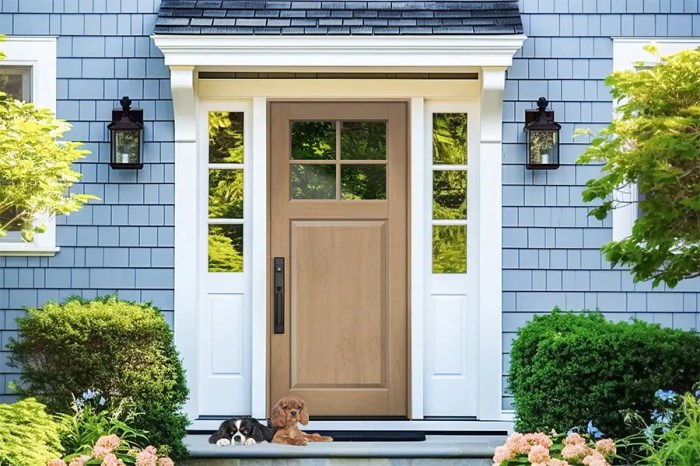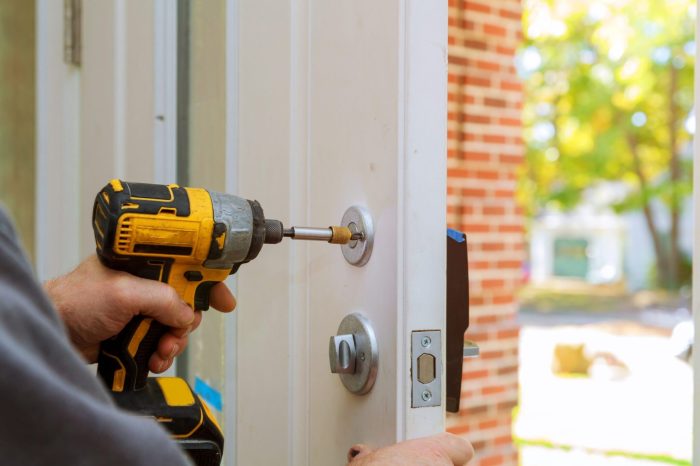Best Materials for Exterior Doors in Coastal Regions: A Comprehensive Guide
Exploring the realm of exterior doors in coastal regions leads us to uncover the best materials that withstand the unique challenges posed by coastal environments. From wood to fiberglass and composite materials, each option offers distinct advantages tailored to coastal living.
As we delve deeper into the characteristics and considerations of these materials, a clearer picture emerges of the optimal choices for coastal door installations.
Types of materials suitable for exterior doors in coastal regions

Wood has been a traditional choice for exterior doors in coastal regions due to its natural beauty and versatility. However, wood is susceptible to moisture and salt exposure, which can lead to warping, rotting, and eventually deterioration. Proper maintenance and finishing are essential to prolong the lifespan of wooden doors in coastal environments.
Characteristics of wood as a material for coastal doors
Wooden doors offer a classic and timeless look that complements coastal architectural styles. However, they require regular upkeep to protect them from the harsh coastal elements. Proper sealing, painting, or staining can help enhance the durability of wood doors in coastal regions.
Comparing the durability of fiberglass versus steel for coastal doors
Fiberglass doors are known for their resistance to moisture, salt, and corrosion, making them a popular choice for coastal homes. They are less prone to warping or rusting compared to steel doors, which can be affected by the salty air and humidity near the coast.
Fiberglass doors are also energy-efficient and offer excellent insulation properties.
Benefits of composite materials for coastal environments
Composite doors combine the best features of different materials, such as wood fibers, resins, and polymers, to create a durable and weather-resistant option for coastal regions. These doors are less likely to warp, crack, or rot, making them a low-maintenance choice for coastal homes.
Additionally, composite doors can mimic the look of wood without the same level of maintenance required.
Considerations for choosing the best material
When selecting materials for exterior doors in coastal regions, several key factors must be considered to ensure durability and longevity in the face of harsh coastal conditions.Moisture resistance is a critical factor to consider when choosing door materials for coastal regions.
The high humidity and frequent exposure to rain and ocean spray can lead to moisture damage and rot if the material is not resistant. Opting for materials that are naturally moisture-resistant or treated to withstand moisture is essential to prevent deterioration over time.The impact of salt air on door materials cannot be underestimated.
Salt air can accelerate corrosion and deterioration of certain materials, especially metals. Choosing materials that are resistant to corrosion and rust is crucial in coastal areas to ensure the longevity of the doors.Material strength is another key consideration for exterior doors in coastal regions.
The doors must be able to withstand strong winds, salt air, and potential impact from debris during storms. Opting for sturdy materials that can endure the harsh coastal environment will ensure that the doors remain functional and secure for years to come.
Maintenance tips for coastal door materials
Maintaining exterior doors in coastal regions is crucial to ensure longevity and functionality. Here are some guidelines for maintaining different types of coastal door materials:
Guidelines for maintaining wooden doors in coastal areas
Wooden doors are susceptible to moisture and salt air in coastal regions, leading to warping, rotting, and deterioration. To maintain wooden doors:
- Regularly inspect for any signs of damage, such as cracks or peeling paint.
- Apply a high-quality sealant or paint to protect the wood from moisture and salt air.
- Keep the door clean and free from debris to prevent mold and mildew growth.
- Reapply sealant or paint every few years to maintain protection.
Best practices for cleaning and protecting fiberglass doors
Fiberglass doors are a popular choice for coastal areas due to their durability and resistance to moisture. To clean and protect fiberglass doors:
- Regularly clean the door with a mild detergent and water to remove dirt and salt residue.
- Avoid using abrasive cleaners or tools that can scratch the surface of the door.
- Apply a UV-resistant gel coat or wax to protect the door from sun damage and fading.
- Inspect the door for any cracks or damage and repair as needed to prevent water intrusion.
Preventing corrosion on steel doors in coastal climates
Steel doors are prone to corrosion in coastal areas due to exposure to salt air and moisture. To prevent corrosion on steel doors:
- Regularly inspect the door for any signs of rust or corrosion.
- Apply a rust-inhibiting primer and paint specifically designed for steel doors.
- Keep the door clean and free from salt residue by washing with a mild detergent and water.
- Consider applying a protective coating or sealant to provide an extra layer of protection against corrosion.
Environmental factors affecting material choice
Sunlight exposure can have a significant impact on different door materials. Materials like wood may fade or warp when exposed to prolonged sunlight, while fiberglass or steel doors are more resistant to sun damage.
Effect of humidity levels in coastal regions
High humidity levels in coastal regions can cause wooden doors to swell, rot, or develop mold. It is essential to choose materials like fiberglass or steel that are not easily affected by moisture to ensure the longevity of the door.
Role of wind and storms in material durability
Strong winds and storms common in coastal areas can cause damage to doors made of weaker materials like wood. Opting for sturdy materials like fiberglass or steel can help ensure that the door can withstand the forces of nature and remain intact during extreme weather conditions.
Summary
In conclusion, selecting the best material for exterior doors in coastal regions involves a careful balance of durability, maintenance, and environmental factors. By understanding the nuances of each material type, homeowners can make informed decisions that enhance both the aesthetic appeal and functionality of their coastal abodes.
Top FAQs
How does salt air affect different door materials?
Salt air can corrode steel doors but has minimal impact on fiberglass and composite materials. Wood may require more maintenance to resist the corrosive effects of salt air.
What are the best practices for cleaning and protecting fiberglass doors in coastal areas?
Regularly clean fiberglass doors with a mild detergent and water to remove salt residue. Applying a protective coating can help prevent damage from UV rays and salt exposure.
How can homeowners prevent corrosion on steel doors in coastal climates?
Regularly inspect steel doors for signs of rust and apply a rust-resistant primer and paint to protect the surface. Keeping the door clean and dry can also help prevent corrosion.




